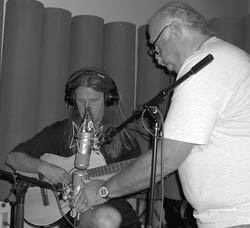
A few days later, Trond arrived on my doorstep, huffing and puffing, carrying an obviously extremely heavy box. They don’t call Trond Braaten the “Norwegian Sherpa” for nothing! (“Sherpa” means mountain- climber from northern Nepal, able to carry very heavy objects great distances.)
That heavy box contained a power amplifier that did change my life! I stared at the lettering on the box, and thought, “Electrocompaniet – holy cow! What a name! It’s almost impossible to pronounce.”
We hooked up the amplifier to my speakers. Great sound! Trond was right, my studio life has not been the same since! They’re wonderfully musical-sounding amplifiers! Those amplifiers go with me to every recording project.
Here are the standard monitoring settings that I use for all my sessions. To set these values I normally use my Simpson (Type 2) SPL meter or a Radio Shack sound level meter.
A. Mid-field monitoring. Westlake Audio Lc 3w12 speakers placed on top of meter over-bridge of mixing desk.
To adjust the Westlake speakers for an SPL level of approximately 93 dB SPL:
Set SPL meter
– “A” scale (OSHA)
– speed “slow” (OSHA)
– range-90
Then:
– Play wide-range complex program material
– Set playback for +3 bus peaks on VU scale
– Observe SPL results (+3 bus peaks =93 SPL peaks)
Then, make mark on monitor level control.
Note: This will result in a good, loud level for mixing popular music. It can be used for a total listening time of four hours of mixing per day. When I mix at this level for two-and-a-half hours and then take a 30-minute break, I don’t experience any ear fatigue when using my Westlake speakers.
Another Note: If lower record bus levels are to be used, adjust SPL resultant peaks accordingly (e.g., If absolute “0” VU bus peaks are to be recorded, then add 3 dB of monitor level before marking the monitor level control).
B. Near-field monitoring. Auratones placed on top of meter overbridge on mixing desk.
To adjust the Auratone speakers for an SPL level of approximately 83 dB SPL:
Set SPL meter
– “A” scale(OSHA)
– speed “slow” (OSHA)
– range-80
Then:
– Play wide-range complex program material.
– Set playback for +3 bus peaks on VU scale.
– Observe SPL results (+3 bus peaks=83 SPL peaks).
Then, make mark on monitor level control.
Note: This will result in a good level for mixing popular music. It can be used for a total listening time of eight hours of mixing per day. If lower record bus levels are to be used, adjust SPL resultant peaks accordingly (e.g., if absolute “0” VU bus peaks are to be recorded, then add 3 dB of monitor level when marking the monitor level control).
Do not monitor at extremely high speaker levels. You should be able to carry on a conversation in the control room while you are mixing. If you have to shout to be heard, turn down the speaker level.
You will only get one set of ear drums in your lifetime, so treat them like the precious things that they are. Who knows – they might be worth a million dollars someday.
Go easy on your ears. Permanent hearing loss can occur very quickly in a control room, especially with some of the new, super high-powered monitor systems in use in modern studios.
